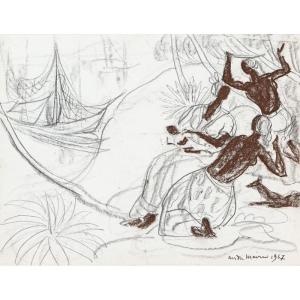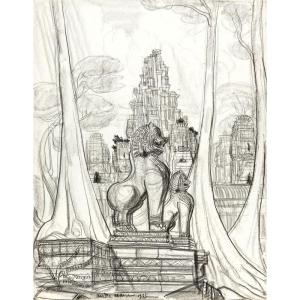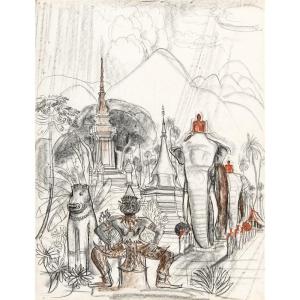Bronze, bearing the foundry stamp "Guyot Fondeur", numbered and signed "A. CHABAUD 1/8"
15 x 22 cm
Auguste Chabaud – Between rural Provence and pictorial modernity
Born in Nîmes in 1882, Auguste Chabaud entered the École des Beaux-Arts in Avignon at the age of just 15, where he was trained by Pierre Grivolas, a renowned master who had already taught René Seyssaud. At the dawn of the 20th century, he moved to Paris, but preferred the excitement of the cafés of the Latin Quarter to Cormon's academic lessons. It was in these lively places that his eye was sharpened, nourished by the daily spectacle, forging a personal, incisive, and modern graphic style. Parisian nightlife fascinated Chabaud. The artificial lights of the city excited his palette, drawing out powerful tones and extreme contrasts. But his native South of France, with its blazing sun, called to him.
Unlike other Provençal painters who exalted light, Chabaud perceived an absorbing light that engulfed color rather than revealing it. He inherited a darker vision, in the tradition of Émile Loubon, Monticelli, and Prosper Grésy. Returning to his family farm in Graveson, Chabaud left the cabarets and brothel girls behind to observe rural life. He now painted peasants, herds, and farm work with the same intensity he had previously devoted to urban life. The draft horse replaced the cab, sensuality became rusticity. This evolution also marks a change in perspective: a disconnected and cynical world gives way to an ancestral rural order, linked to the seasons, the nourishing earth, and the rhythm of life. This strict framework becomes the foundation of his art, both a constraint and a source of inspiration.
In Chabaud's painting, the limited palette concentrates the tension: a deep blue, sharp blacks, grayish whites, conveying raw emotion. Far from Provençal folklore, his work stands out for its rugged modernity and instinctive truth. Chabaud does not paint to seduce: he paints life, in its harshness, its beauty, its organic mystery. His work, humble in appearance, expresses a profound ambition: to probe primary instincts, to evoke sexuality as a vital force, death as an inevitable horizon.
In January 2014, the Alexis Pentcheff Gallery dedicated a major retrospective exhibition to him: Auguste Chabaud, l’instinct de vie (Auguste Chabaud, the instinct for life), paying tribute to a singular artist, independent of fashion, whose painting continues to resonate with rare force.
Discover more works by this artist on the gallery's website: https://www.galeriepentcheff.fr/fr/peintre-auguste-chabaud#Oeuvres




























 Le Magazine de PROANTIC
Le Magazine de PROANTIC TRÉSORS Magazine
TRÉSORS Magazine Rivista Artiquariato
Rivista Artiquariato